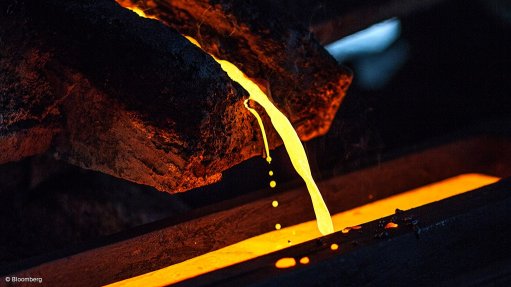
Photo by: Bloomberg
JOHANNESBURG (miningweekly.com) – Thomson Reuters GFMS is expecting to see substantial price hikes for base metals in the medium term, but says prices will remain “largely muted” in 2016.
Base metals prices were between 12% and 34% lower than at the start of this year, the latest Thomson Reuters GFMS Base Metals Review and Outlook report shows.
The report authors noted that the top ten base metals miners had a combined market value of just over $280-billion – about half of what it was 12 months earlier and almost a quarter of the peak of the super-cycle in early 2011.
“Overall, the landscape for the mining sector looks rugged. The clock has turned back commodity prices and revenue to levels last seen in 2008/9, while, over the same period, debt on the combined balance sheets of the ten miners is more than 50% higher,” the report pointed out.
Thomson Reuters GFMS said free cash flow was holding up, but only as a result of “drastic” cuts to capital expenditure (capex), which would partly impact mining flexibility and future growth plans.
Further downside to commodity prices would, therefore, be much tougher to absorb.
“The result will be, in our view, better discipline on the supply side with meaningful cuts to marginal cost production, which should provide support to prices for a number of the base metals,” the authors stated.
In addition, project deferrals and capex cuts would dent future supply growth.
The authors averred, however, that while sentiment remained firmly negative, “we are sowing the seeds for the next mining boom, as supply, once again, falls out of sync with global demand growth, albeit at a slower pace this time around”.
NICKEL
Thomson Reuters GFMS forecast a 9% rise in nickel prices in 2016, predicated on further supply constraints coinciding with stronger consumption from the key stainless steel sector.
The company said demand had been “knocked” by a prolonged destocking cycle that began in late 2014 and continued into the early months of 2015 to more than counter lower supply, leaving the market in a forecast 40 000 t surplus in 2015.
“Considerably more than half of the world’s nickel producers are estimated to be losing money, however, and further curtailments look set to come through that will tip the market into a 30 000 t deficit,” the report stated.
Thomson Reuters GFMS further noted that, while this was unlikely to “set nickel alight” given that it would make only a small dent in the continued “vast inventory overhang”, industry watchers would be heartened by the fact that fundamentals would be moving in the right direction, with further deficits expected in subsequent years.
COPPER
The report further stated that the copper market was close to bottoming out and Thomson Reuters GFMS expected it to finally turn the corner in 2016.
“While prices will improve only marginally, by 4%, on a yearly average basis, the gradual upwards slope will see them end 2016 substantially higher than present levels.”
However, although it had previously been “somewhat cautious” on the extent to which recent price-related production cutbacks, to date, would impact copper supply, the company predicted this would now help to reduce the expected surpluses this year and next.
Further, as miners continued to react to current weak prices, additional supply responses were expected, indicating a return to deficit from 2017.
“Global copper demand growth, which has been crimped to little more than 2% this year will also play a greater part in improving market fundamentals, helped, despite a degree of caution on the figures bandied around, by investment in China’s power network, as well as by the One Belt One Road policy.”
The One Belt One Road policy was aimed at finding new markets for excess goods produced in China.
ALUMINIUM, ZINC AND LEAD
Meanwhile, the prospects for aluminium, zinc and lead in 2016 looked comparatively less inspiring than those for copper and nickel.
The former would continue to be “plagued” by the seemingly relentless rise in output.
“While we are building in slower supply growth next year than this year’s hefty 7.4% forecast, which has been fuelled by continued strong expansion of lower cost capacity in China, this will still leave the market in around a 500 000 t surplus.
“With no sign of deficits on the horizon in the medium term, weak prices remain the order of the day for this metal,” Thomson Reuters GFMS said.
The report added that the zinc market had to contend, yet again, with the disappointment that the closure of some of the world’s largest mines was not going to result in a substantial deficit again the following year and this was reflected in an expected 7.7% decline in prices in 2015, to be followed by a “mere” 1.5% increase in 2016 to $2 030/t.